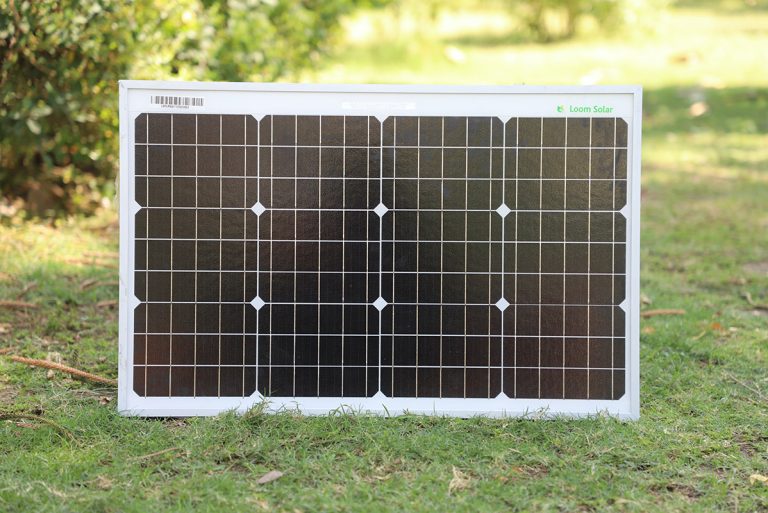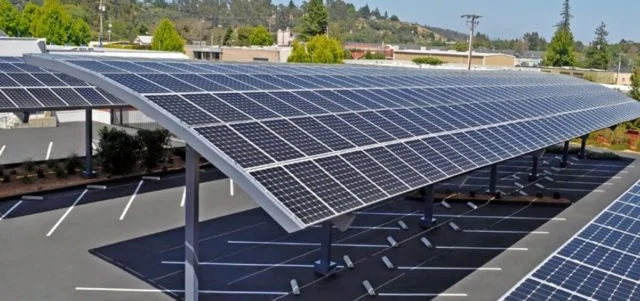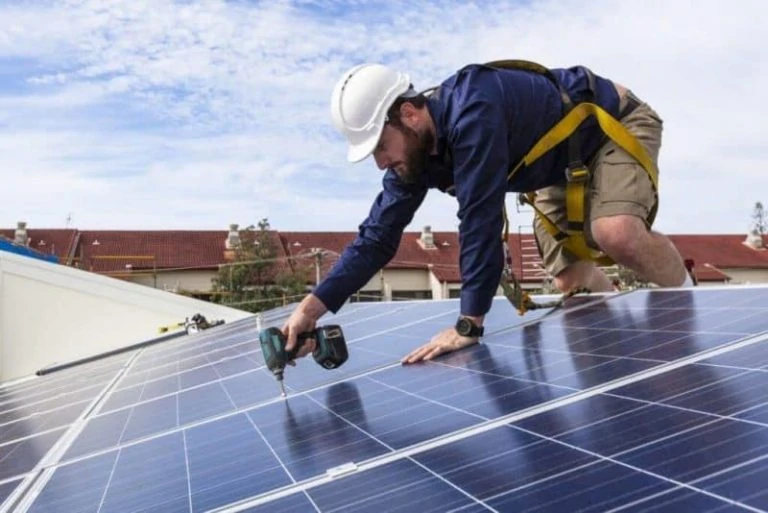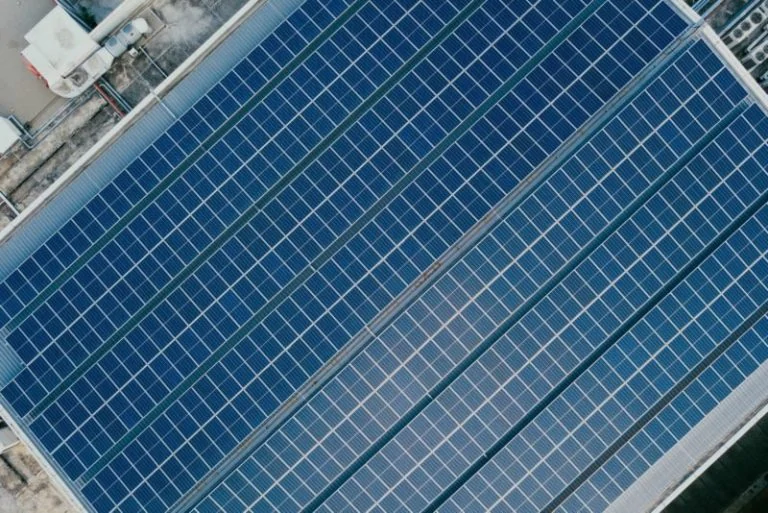Have you noticed your home electric bills skyrocketing recently? You’re not alone.
Or possibly you’re worried about the effects of heatwaves or other climate extremes on the functioning of your local power grid.
Power failures aren’t any fun. They may even be deadly.
To achieve energy security and independence, as well as to offset high energy bills, more and more homeowners are considering residential solar or solar & battery storage — both of which are on the rise in the United States.
Naturally, you’re wondering if the solar power output from a rooftop or ground-mount solar array would be adequate to meet all of your family’s energy needs without breaking the bank.
In this complete guide to solar power output, you’ll find out everything you need to know about how much energy a solar panel produces. Then, you’ll be able to make an informed decision about whether a residential solar energy system is right for you.
How much energy does a solar panel produce?
People who ask how much energy a solar panel produces often want to know if one photovoltaic (PV) panel can make a certain appliance run.
The short answer is: depends on the appliance and the panel’s power rating.

If you’re thinking about going solar for an RV or camping trip, you definitely must know how much energy a solar panel produces.
If you miscalculate, you could be in a tight spot.
But if you’re considering a solar setup for your home, you also need to know how much energy a solar panel produces.
Like all appliances, solar panels are rated in watts. Watts are a unit of electrical power and noted by W.
One thousand watts equals one kilowatt (kW). Expressed another way: 1,000 W = 1 kW.
Watts and watt hours explained: Refrigerator example
As an example to explain what the watts unit of measurement means, think of an older, large refrigerator. It may be rated at 1,000 W. (Check the label to find yours.)
The conventional understanding of wattage means the appliance consumes 1,000 watts of electrical power to run for one hour.
Another way to express this is to say it takes 1 kilowatt hour (kWh) of electrical energy to run a fridge rated at 1,000 watts for one hour.
But this explanation is inaccurate. (And it’s relevant to solar panels, too, if you’ll stay with me.)
In reality, a manufacturer’s label refers to the output wattage of the appliance. What a motor-driven appliance like a refrigerator actually needs to get started to operate (that is, the input wattage or starting surge) will be higher than what’s on the label.
The reason for this difference between input and output wattage is partly due to the inefficiency of an appliance in converting incoming electrical power to outgoing work. In other words, some energy is lost to the surroundings as heat or sound during normal startup operation.
In the case of a fridge, the outgoing work is keeping food cold or frozen.
Depending on the age and brand, a refrigerator rated at 1,000 W will need a greater startup wattage or power surge — 2,000 W or more — to do 1,000 W worth of keeping foods cold or frozen.
You can check out exactly how much energy is used by your appliances with a Kill A Watt meter.
You may be wondering: What does this have to do with solar panel power ratings?
A solar panel manufacturer will rate solar panels by wattage just like appliance makers. Today, most residential PV modules are rated at 300-450 W each.
This is the output wattage of solar panels. It’s the amount of electrical power a solar panel can be expected to generate when exposed to the sun for one hour under ideal conditions.
It’s also called a power rating.
However, there is also an input wattage of a solar panel. Although there is no motor in a PV panel that requires a power surge to get started like you saw with the refrigerator example, there is a huge input wattage for solar panels.
It comes from the sun and is called irradiance (brightness).
Irradiance
The amount of solar power coming from the sun and landing directly (perpendicularly) on a surface measuring one square meter (approximately 3 ft.2) is called irradiance. It’s measured in W/m2.
After passing through Earth’s atmosphere where it reflects off airborne particles and scatters or is absorbed by air molecules, a portion of the sun’s rays eventually reaches the ground (or your rooftop solar array).
When scientists measure irradiance at a location on the equator on a cloudless day while the sun is at its highest point in the sky, (called solar noon), they find the irradiance to be approximately 1,000 W/m2 (1 kW/m2). This value refers to solar power at “full sun” or “peak sun” and is called a peak sun hour.
Here’s a graph that illustrates how peak sun varies with the seasons:

Irradiance and peak solar power output: Summer vs. Winter
The graph above explains why solar panels can produce more output wattage during the summer vs. the winter. There is simply more solar irradiance (in watts per square meter) during longer periods of summer days.
However, this general conclusion is oversimplified.
Solar panels function best when it’s cool. Then the electrical connections between solar cells and those linking panels together won’t get overheated. If they do, the wires offer greater resistance to electrical transmission from the roof (or backyard for a ground mount system) into your home.
In the summer, although irradiance is more intense, your panels are too hot to produce their maximum energy output.
The temperature coefficient of the panel determines how much energy will be lost. Depending on panel quality and the temperature, it could result in a 16% loss or more in energy production. The temperature coefficient is also on the spec sheet.

However, don’t automatically assume that PV panels have greater solar power output during the winter.
Although it’s colder, there’s yet another problem that hinders optimal solar power output.
The angle of the sun’s rays on your panels in the winter are far from direct (perpendicular). This poor angle decreases solar absorption of less intense sunlight.
So, solar power output in the winter will be reduced compared to what it could be if the solar rays hit the panels at a perpendicular angle.
How can I maximize solar power output? The effect of seasonal changes
The ideal way to overcome high heat issues in the summer and angle concerns in the winter as much as possible is to use solar tracking.
In this method, PV panels move during the day, tracking the sun as it makes its trajectory across the sky and keeping the modules perpendicular to the solar rays’ impact.
Alternatively, if you can’t afford solar tracking, a ground mounted solar array that’s adjustable to meet the sun’s position in the sky and approximate perpendicularity through the seasons is preferable to rooftop solar where the modules are fixed (stationary) at one angle.

Elevated and angled on poles in a ground mount system, the panels receive the sun’s rays more directly. After angle adjustment, there will be better solar absorption and, thus, greater solar power output.
Here is a helpful guide from an experienced solar installer to know which angle is best for your solar system depending on the season and your location.
How much energy does a solar panel produce in the summer vs. the winter? An example using irradiance
Here’s an example that gives you an idea of how irradiance determines solar panel output wattage.
Based on the graph shown above, you calculate the amount of energy a solar panel can produce in the summer or winter using the irradiance and estimated number of peak sun hours in your location.
How much solar power output is possible in the summer?
According to the graph above, peak sun at 900 W/m2 lasts for 6 hours a day in the summer. (This is an average.)
900 W/m2 x 6 hrs = 5,400 Wh/m2 = 5.4 kWh/m2 = 5.4 peak sun hours
(Since 1 kWh/m2 = 1 peak sun hour, there are 5.4 peak sun hours in an average summer day.)
For a 400 W solar panel that’s one square meter in area, exposed to direct sun for 6 hours under ideal conditions:
400 W x 5.4 peak sun hours = 2,160 Wh/day
So, a single 400 W solar module that’s one square meter in area could run a 1,000 W refrigerator for an hour (assuming the startup power surge is under 2,160 W. An extra 400 W panel contributing another 2,160 Wh/day would eliminate any doubts).
However, since you need the fridge 24/7, even though the motor cycles on and off, a battery backup or connection to the utility grid is essential.
Caution
- Do not directly connect a major appliance like a refrigerator to the solar panel unless the panel has a built-in charge controller and inverter. Without them, raw input wattage from the PV panel could damage the appliance. In addition, a major home appliance needs higher-voltage AC current (listed on the label), but the PV panel generates lower-voltage DC current.
- An inverter will make the changes. It may be prudent to have a dedicated circuit for the fridge in your home, or one that doesn’t have much load on it already, to avoid tripping the breaker by startup power surges. If you’re doing off-grid solar, a battery bank in addition to a charge controller and inverter (unless it’s a DC fridge) will ensure you have the power to run the refrigerator safely and at night or on cloudy days.
How much solar power output is possible in the winter?
From the graph shown previously, peak sun at 500 W/m2 lasts for three hours in the winter. (This is an average.)
500 W/m2 x 3 hours = 1,500 Wh/m2 = 1.5 kW/m2 = 1.5 peak sun hours
(Since 1 kWh/m2 = 1 peak sun hour, there are 1.5 peak sun hours in an average winter day.)
For a 400 W solar panel that’s one square meter in area, exposed to direct sun for 3 hours under ideal conditions:
400 W x 1.5 peak sun hours = 600 Wh/day
So, a single 400 W solar module could not run a 1,000 W refrigerator by itself in the winter.
You’d need four additional PV panels (400 W each) for the refrigerator to run reliably off of these solar modules in the winter for an hour and handle the startup power surge. If you did, you’d have 5 x 600 Wh = 3,000 Wh/day.
Since you need the fridge for more than an hour every day, battery storage or grid connection is necessary.
The caution note given above applies here, too.
Key takeaways about solar power output from the irradiance example
If you live in an area with greater peak sun hours, a smaller-sized solar system — in terms of total output wattage — will provide you with all or most of the solar power output you need to meet energy demands.
By contrast, if you live in a region with fewer peak sun hours, you’ll need a larger solar system to cover all of your energy needs.
Although this example is simplified, it tells you how irradiance and sun hours directly determine solar power output of a residential solar array.
This example allows you to estimate how much energy each solar panel produces (output wattage) based on the sun’s brightness (irradiance) in your area.
How to use sun hours to calculate solar power output
To simplify the calculation for the amount of energy a solar panel produces, solar companies may simply use sun hours based on irradiance.
There are sun hour maps which you can consult to get a more precise value for various times of the year in your region. The resource maps by the National Renewable Energy Laboratory are excellent.

The higher the output wattage of a PV panel and the more peak sun hours in your area, the greater amount of electricity your system will generate.
For example, California and Arizona receive 6-8 sun hours per day. For Alaska and New York, it’s only 3-4 sun hours/day.
Alternatively, you could use NREL’s PVWatts Calculator for more precise information. Input your address to get yearly and monthly peak sun hours.
Multiplying the output wattage by the number of sun hours in your location gives you the total energy produced in one day, expressed in watt hours, under ideal conditions:
Energy (Wh) = Labeled Output Wattage (W) x Sun Hours (h)
However, basing your estimate of the grid-tied solar array size that’s right for you on this value will lead you to purchase a system that’s too small to meet all your energy needs.
The reason for this is that the panels’ labeled output wattage was established during ideal conditions which rarely occur in the real world.
As a general rule of thumb, assume that real-world conditions (including cloudy or snowy days and hot weather) will lower the actual energy produced by a PV panel by approximately 25% over the course of a year.
A cloudy day, for instance, can lower solar power output by 20%! Dirty panels can reduce it by 6.5%.
As an example using the 25% loss, a 400 W solar module exposed to 4 sun hours per day will produce:
400 x 4 x 0.75 = 1,200 Wh = 1.2 kWh of electrical energy each day on average over the course of a year.
Not 400 x 4 = 1.6 kWh per day.
Although there may be cold, sunny days when your solar panels generate more than their labeled wattage, don’t expect this to happen frequently enough to counteract the loss of power on hot or cloudy days.
To meet your energy needs, be sure to factor in a 25% loss of solar power when sizing a grid-tied solar array for residential or business purposes using spec sheet output wattage. (Note: Off-grid solar calculations are different.)
Even with the loss of solar power due to non-ideal conditions, there is enough of it to power the world with solar energy alone 10,000 times over:
If only humans could figure out how to capture all that energy and use it efficiently.
What are the savings on electric bills from solar panels?
According to the U.S. Energy Information Administration, the average cost of electricity in 2021 was approximately 14 cents/kWh.
So, for example, a 400 W solar panel in a location with 4 sun hours, assuming a 25% reduction in power output due to non-ideal conditions, can generate 1.2 kWh per day. That’s equivalent to 14 x 1.2 = 16.8 cents from a single PV module every day.
If you have 24 solar panels of the same wattage in your rooftop or ground mount solar system, that’s 24 x 16.8 cents = $4.03 per day shaved off your electric bill.
In a month, that’s a savings of $4.03 x 30 = $120.96.
For a year, that comes to $120.96 x 12 = $1,451.52.
Although a solar setup may not generate the same power all year long (due to weather, dirt, shade, poor angle or orientation, or just normal degradation) you can count on significant savings on electric bills when you go solar as long as the sun shines.
How many solar panels are needed to fully power a home?
An average household in the United States uses approximately 30 kWh of electricity every day.
To give you an idea of how many panels you’d need in a rooftop or ground mounted solar array to generate 30 kWh per day in a region with 4 sun hours and using 400 W panels that produce 1.2 kWh each (assuming a 25% power reduction due to non-ideal conditions as shown above):
30 / 1.2 = 25 PV panels
To find out how large an area of space you would need to install an array of 25 panels, consult the panels’ spec sheet for their spatial dimensions and do the math. A 5 x 5 array (five strings of five modules each) is the logical choice. But if you have an irregularly shaped roof, you may arrange the 25 panels differently.

Although it’s possible to generate enough solar power to run an entire home anywhere, you may need many more higher-wattage PV panels in northern states where there are fewer sun hours.
By contrast, in sunny southern locations, fewer panels will suffice to power a home, and they may not have to be high wattage either.
How is the output wattage of a solar panel calculated?
Solar manufacturers use irradiance, under standard test conditions, known as STC, to determine the output wattage (power rating) of their solar panels.
These conditions are:
- 1000 W/m2 irradiance
- PV cell temperature of 77°F (while air temperature is 32°F)
- Absolute air mass spectra (a measure of atmospheric thickness) of AM1.5
STC is what you see on the label and the specification sheets with a tiny asterisk beside it indicating a footnote.
To put it into ordinary language, STC is like a clear, windless, bright winter’s day.
That STC asterisk on a spec sheet tells you the solar company replicated the environmental conditions (STC) to get 1,000 W/m2 as the input wattage in a laboratory setting. Then they measured their panels’ output wattage (power rating) under those conditions.
In reality, at other locations on the Earth on any particular day when the standard conditions are not met, irradiance may be significantly less — possibly as low as 200 W/m2!
And even though the air temperature may be mild (68°F), the PV cells could be burning up at 50-90°F hotter in direct sunlight. This could easily cut 20% off of energy production.
The diagram below illustrates why ground mounted arrays have an advantage over rooftop solar: heat can dissipate under the panels to keep PV cell temperature under control and prevent huge power loss.
When they’re installed on a roof, there isn’t sufficient space under them to allow the panels to cool off.

In the real world, 52% of all incoming solar radiation is lost. Some of it goes back into space or is randomly scattered or absorbed in the atmosphere.
In addition, approximately one third of the solar radiation that actually arrives at Earth’s surface and hits a photovoltaic cell inside a solar panel is not absorbed by the PV cells and converted into electrical energy.
The reason it’s not absorbed is that these photons (light energy) from the sun don’t have the correct energy level to knock off electrons in the silicon of the PV cells. The knock-off process is how solar energy is converted into electrical energy.
Instead, these photons are simply absorbed as thermal energy or released as heat energy.
Does efficiency determine wattage of a solar panel?
Because the solar energy conversion to electrical energy is not perfect, solar cells are not too efficient at making electricity.
Today, top-of-the-line solar panels have 23-24% efficiencies.
The efficiency of a solar panel does not determine its wattage.
So, you will find on the market 300 W panels of 23% efficiency and 400 W panels of 16% efficiency.
The higher a PV panel is rated for wattage, the more electricity it can generate, whatever its efficiency may be. How well a solar module converts sun energy (that is, its efficiency) is already taken into account during the testing process to rate its output wattage.
Why is it important to know solar power output?
If you’re in the market for a rooftop or ground mount solar system, solar companies will quote you an estimated price.
They will most likely base their estimate using a dollar per watt metric.
According to the Solar Energy Industries Association, in 2021, the price per watt of a residential solar array in the United States was approximately $3.05/watt.
For a typical U.S. solar system size of 6 kW (6,000 W), that will come to:
$3.05 x 6,000 W = $18,300 before tax incentives
Because of the Biden Administration’s Inflation Reduction Act passed in August 2022, there will be a 10-year extension for the federal solar investment tax incentive at 30% of installation equipment costs until 2032. Then it will step down to 26% in 2033 and to 22% in 2034.
Solar power output: The role of voltage and current
When a solar manufacturer measures a panel’s output wattage with a device called a digital multimeter under standard test conditions, they plot a current (I) vs. voltage (V) graph like the one below to arrive at the maximum output power point (MPP or PMP):

The maximum solar power output (PMAX) — located on the graph where the curve bends — is defined by this equation:
P (watts) = V (volts) x I (amps)
In words, power measured in watts equals voltage measured in volts multiplied by current measured in amps.
On a PV panel’s specification sheet, you’ll find numerical values for many of the quantities shown on the graph above.
For example, here are data taken from the spec sheet of Trina Solar’s 380 W solar panel:
| Peak Power (PMAX ) | 380 W |
| Maximum Power Voltage (VMP) | 40.3 V |
| Maximum Power Current (IMP) | 9.43 A |
| Open Circuit Voltage (VOC) | 48.8 V |
| Short Circuit Current (ISC) | 9.94 A |
Since PMAX = VMP x IMP,
380 W = 40.3 V x 9.43 A
The higher the electrical currents and voltages produced by a solar panel, the greater will be its output wattage. All panels will show a similar curve as the one above.
The brighter the sun (that is, the greater irradiance) hitting the panel, the higher the electrical current passing through it will be.
Incidentally, the efficiency of a solar panel (also listed on the spec sheet) is calculated based on the PMAX value generated under STC.
Efficiency is equal to the ratio between the maximum power generated per unit area of the panel, (POUT), and the incoming power, expressed as a percent:
Efficiency (%) = POUT / PIN = [VMP x IMP /Area of PV cell] /PIN x 100
Under STC, the incoming power (PIN) is the irradiance of 1,000 W/m2.
FAQs about solar power output
Here are a few commonly asked questions and their responses about solar power output and how much energy a solar panel produces.
Will a solar panel rated at a certain wattage always produce that amount of solar power?
Unless ideal conditions are met all the time (direct sun falling perpendicularly on the photovoltaic cells on a cloudless, cool day), solar panels will rarely produce their stated wattage on a regular basis.
The angle of the panels, their directional orientation, the air temperature, the temperature at the panels, the temperature coefficient, and the degradation rates all have major effects on exactly how much energy a solar panel produces.
To increase the likelihood of maximum solar power output, purchase high-quality PV panels using the latest technology with a solid warranty from a reputable company. Then match them with a top-of-the-line inverter and charge controller that can handle that level of solar power output.
Of course, make sure that their angle and orientation toward the sun are optimal. And that they’re dust- and dirt-free, away from shading by trees or buildings.
High efficiency of the panels is not a guarantee that your panels will achieve optimal solar power output. So, for instance, while monocrystalline panels are more efficient than polycrystalline modules, if their rated wattages are the same, their solar power outputs should be the same, too.
However, more efficient solar panels will have lower degradation rates, meaning they’ll last longer while still performing at 90% of their initial power output even after 20-25 years of energy production.
What is NOTC and PTC on a solar panel spec sheet?
When a solar manufacturer measures how much energy a solar panel can produce, they use standard test conditions (1,000 W/m2 irradiance, 77°F, and AM1.5) noted as STC replicated in a lab setting.
There are other test conditions — called NOTC or PTC — used to determine a PV panel’s power output. Some solar manufacturers may include this information on their spec sheets.
NOTC
Sometimes, a company will also test their panels under NOTC, which stands for nominal operating cell temperature. These are defined as:
- Irradiance of 800 W/m2
- Air temperature of 68°F
- PV cell temperature of 113°F
- Wind speed of 2.2 mph
NOTC offers a glimpse into a panel’s output wattage variability under a certain set of real-world conditions. Sometimes, NOTC ratings could show a negative difference of 100 W or more from the manufacturer’s stated output wattage under STC.
The discrepancy is often due in part to the power loss at higher temperatures. It’s not unusual to lose 15-20% of power output when it’s hot outside, especially with inferior panels whose temperature coefficient is high.
This is why you should expect a panel’s power performance to be at least 25% lower on average, over time, than whatever the labeled wattage is.
Likewise, expect at least a 25% reduction in the total power output that you calculate based on labeled wattage of a rooftop or ground mount solar array consisting of 16-30 panels. (Of course, there are exceptions to every rule, but this is still a good general rule of thumb.)
PTC
Another way to test solar panels for output wattage is using PTC. This is an abbreviation for PVUSA test conditions.
PTC is defined as:
- Irradiance of 1000 W/m2
- Air temperature of 68°F
- Tested at 30 ft. above ground level
- Wind speed at 2.2 mph
- Air mass spectra of 1.5
California uses PTC when it calculates rebates as part of the California Solar Initiative (CSI) Program.
PTC is considered to be more like conditions in the real world than STC.
Does the wattage of a solar panel determine its size?
Strictly speaking, a PV panel’s wattage does not determine its size. Thus, you can find PV modules on the market rated 100 W up to 450 W, and all may be approximately the same size in total area.
On the other hand, the efficiency of how well a panel converts sunlight into electrical energy partly determines panel size (in terms of total area) for a desired output wattage.
For example, a high-efficiency (23%) module rated at 300 W will most likely be smaller than a lower-efficiency (17%) panel also rated at 300 W.
However, a solar panel of 18% efficiency may have an output wattage rating of 300 W while a higher-efficiency module, of the same size, can produce 400 W.
The reasons why this is true are three-fold:
- The PV cell technology in a high-efficiency panel is more advanced (example: heterojunction HJT cells).
- The photovoltaic material is superior (monocrystalline better than polycrystalline; N-type better than P-type).
- The busbars and fingers (metal ribbons) configuration minimally interferes with solar absorption or is placed only on the panel back of a standard (not bifacial) PV panel.
So, greater solar energy conversion to electrical energy is possible on a smaller area in a solar panel of higher efficiency.
This is why, when space is a limiting factor, high-efficiency panels rated at 375-450 W will require less roof or backyard area, even if your energy demands are great (8-12 kW solar system rather than the typical 5-6 kW array).
You will need a larger surface to support more lower-efficiency panels of the same or lower wattage in similarly-sized solar systems.
The trend among PV panel manufacturers these days is to increase both efficiency and power performance of solar panels by making individual photovoltaic cells larger and often splitting them in two (half cell technology). The larger cells are placed on larger panel sizes.
So, instead of the traditional 6-inch solar cell, today you’ll find 6.5-, 7.2-, or 8.3-inch cells. There may be 60 or 72 (or, in the case of half-cell technology, 120 or 144 cells, respectively) of these larger cells arranged on a single module.
Bigger cells require larger panels with more PV cell surface area. Half cell technology capitalizes on this fact.
In other words, in a panel with 120 or more half cells, the electric current going into each half of one photovoltaic cell is also halved. The reduction of current lowers resistance to electrical transmission, and, subsequently, reduces energy losses. So, there is an increase in output wattage and often in panel efficiency, too.
Key takeaways on solar panel power output
It’s fairly straightforward to calculate how much energy a solar panel produces by the formula below:
Solar panel wattage (W) x Number of sun hours (h) = Solar energy output (Wh)
However, there are many factors that determine whether a single solar panel will produce its rated wattage. The most important factors include:
- Number of sun hours in your area
- Local weather and climate conditions
- Panel angle and orientation toward the sun
- Temperature coefficient of the panel
- Degradation rates of the modules
- PV cell technology
Typically, an average American household will have 16-30 panels of 300-450 W each in a solar system located on their roof or in the backyard. Depending on the panels’ wattage and their number, the total size of the array will be approximately 5-12 kW. When weather and climate cooperate — and barring major malfunctions — this amount of solar power output can meet or surpass your family’s energy requirements.
Energy your solar system generates that you don’t need may be sent back to the public utility grid in grid-tie systems. In most states, homeowners receive an energy credit for this through net metering programs.
Or, you may opt to install a solar + storage system in which case the energy you don’t use immediately is stored in a battery until you need it (like when the electric grid fails or when electric rates are highest).
In both scenarios, the solar power output of your residential solar system will lower your home energy bills and go a long way toward achieving carbon-free energy independence for you.













